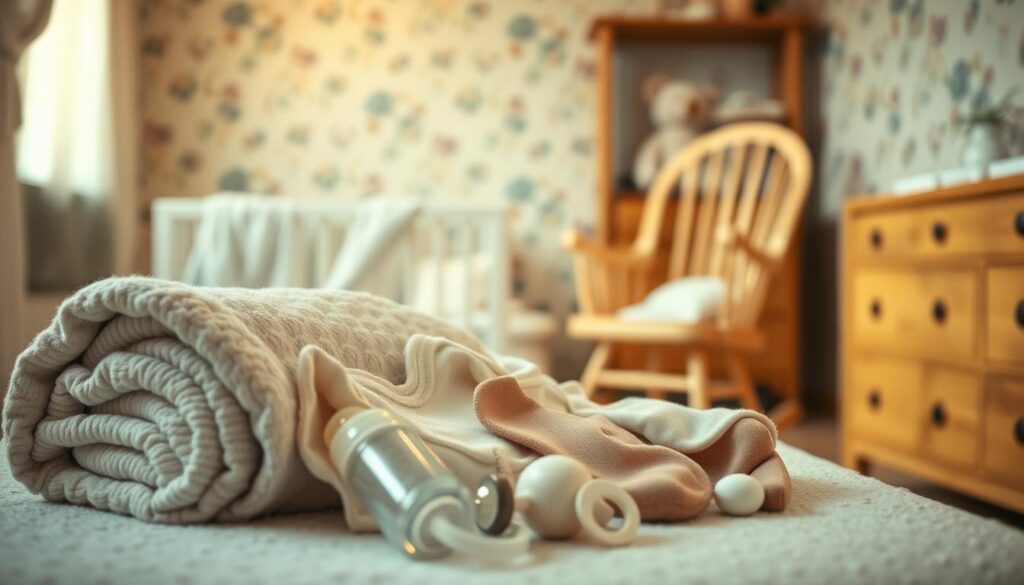Welcoming a new baby is both exciting and scary. There are so many things to do, like feeding, bathing, and making sure they sleep well. It’s normal to wonder how to keep your baby healthy.
Caring for your newborn is more than just the basics. It’s about making a safe space for them to grow and thrive. This guide will cover the key parts of newborn care. We’ll talk about feeding, sleep, and health checks to help you feel more confident.
Key Takeaways
- Understanding the basics of infant health and nutrition.
- Establishing a safe and comfortable sleep environment.
- Learning effective soothing techniques for your baby.
- Recognizing the importance of regular health checkups.
- Creating a nurturing environment for your baby’s growth.
Understanding Newborn Development
As a new parent, it’s key to know about your newborn’s growth. In the first month, babies go through big changes in their body and feelings.
Key Milestones in the First Month
In the first month, your baby will hit many important milestones. They’ll start to react to sounds and follow things with their eyes. You can help by talking to them and using toys with different textures and colors.
Look out for these milestones too:
- Lifting their head while on their stomach
- Bringing their hands to their mouth
- Responding to touch and voice
Emotional Bonding with Your Baby
Emotional bonding is crucial for your baby’s growth. It can be strengthened through skin-to-skin contact, eye contact, and being a responsive parent. By meeting your baby’s needs, you make them feel safe and loved.
Here are ways to boost emotional bonding:
- Engaging in skin-to-skin contact
- Maintaining eye contact during feeding and play
- Responding to your baby’s cries and needs
Importance of Touch and Interaction
Touch and interaction are vital for your baby’s growth. They help with both physical and emotional development. Simple actions like stroking their skin, holding them close, and playing with them can make a big difference.
| Activity | Benefits |
|---|---|
| Skin-to-skin contact | Promotes emotional bonding, regulates body temperature |
| Eye contact | Enhances emotional bonding, supports cognitive development |
| Responsive parenting | Fosters a sense of security, supports emotional development |
Essential Newborn Supplies
Getting ready for a new baby can feel overwhelming. But, knowing what you need is key. Focus on the essentials that keep your baby safe and comfy.
Must-Have Baby Gear
Baby gear must be safe and useful. You’ll need a car seat, stroller, and baby monitor. These items are crucial for your baby’s safety and your peace of mind.
Key Features to Consider:
- Car seat: Find one that fits your car and is easy to use.
- Stroller: Look for one that’s sturdy, easy to push, and has lots of storage.
- Baby monitor: Choose one with clear video and sound. Extra features like temperature sensors are a plus.
Choosing the Right Crib and Mattress
Choosing the right crib and mattress is vital for your baby’s sleep. Make sure the crib meets safety standards and has a firm, snug mattress.
Tips for Crib Selection:
- Check for any recalls on the crib model.
- Ensure the crib has a sturdy construction and no missing or loose parts.
- The mattress should fit tightly, with no gaps between the mattress and the crib walls.

Diapers: Cloth vs. Disposable
Choosing between cloth and disposable diapers depends on your lifestyle and values. Both have their advantages and disadvantages.
Cloth Diapers: They’re good for the environment, save money, and can be tailored to fit your baby.
Disposable Diapers: They’re easy to use and widely available.
In the end, the choice between cloth and disposable diapers depends on what’s best for you and your baby.
Feeding Your Newborn
As a new parent, it’s key to know about feeding options for your newborn. Feeding is a big part of caring for them. It’s important to make smart choices.
Breastfeeding Tips for New Moms
Breastfeeding is best for your newborn and helps you bond. To breastfeed well, you need to get a good latch. This means your baby’s mouth should cover the areola, not just the nipple.
Here are some tips for good breastfeeding:
- Feed your baby often, 8-12 times in 24 hours.
- Watch for signs they’re getting enough, like steady weight gain and wet diapers.
- Think about getting help from a lactation consultant for advice.
Formula Feeding Basics
If you can’t or don’t want to breastfeed, knowing about formula is important. Pick a formula that’s iron-fortified and right for your baby’s age.
Always mix formula as the maker says to. Also, make sure to clean bottles and nipples well before use.
| Formula Type | Description | Key Benefits |
|---|---|---|
| Cow’s Milk-Based | Most common type, suitable for most babies. | Provides essential nutrients, supports growth. |
| Soy-Based | Alternative for babies with dairy intolerance. | Lactose-free, suitable for sensitive stomachs. |
| Hypoallergenic | For babies at risk of allergies or with sensitive stomachs. | Broken-down proteins reduce allergy risk. |
Introducing Solid Foods: When to Start
When your baby is ready for solid foods, it’s a big step. Babies usually start between 4 to 6 months. They show they’re ready by being interested in food, having good head and neck control, and sitting up with support.
Start with simple foods like iron-rich rice cereal or pureed meats. Add new foods one at a time. Watch for any signs of allergy or intolerance.
Remember, every baby is different. Always talk to your pediatrician before changing your baby’s diet.
Sleep Patterns and Safety
Ensuring your newborn gets enough sleep safely is key in parenting. As a new parent, it’s important to know your baby’s sleep needs. Also, creating a safe sleep environment is crucial.
Newborn Sleep Needs
Newborns sleep a lot, usually between 16 to 20 hours a day. They sleep in short periods and wake up often for feeding.
Key aspects of newborn sleep needs include:
- Sleep cycles are short, lasting around 20-30 minutes.
- Newborns can sleep a lot during the day and be more awake at night.
- Feeding schedules can impact sleep patterns.
Safe Sleep Practices
To ensure your baby’s sleep is safe, follow these guidelines:
- Always place your baby on their back to sleep.
- Use a firm, flat mattress and keep the crib free of soft toys and loose bedding.
- Avoid bed-sharing with your baby.
Creating a clutter-free crib is not just about safety; it’s also about helping your baby sleep better.
Creating a Calm Sleep Environment
A calm environment can improve your baby’s sleep quality. Techniques to achieve this include:
- Swaddling your baby to make them feel secure.
- Using white noise machines to block out other distracting sounds.
- Maintaining a comfortable room temperature.

By understanding your baby’s sleep needs and implementing safe sleep practices, you can help them get the rest they need. This not only benefits your baby but also helps you as a parent. It can improve your own sleep and reduce stress.
Immunizations and Health Checkups
Keeping your newborn healthy is key. This includes immunizations and health screenings. As a new parent, knowing how these protect your baby is vital.
Vaccination Importance
Vaccines are crucial for newborn care. They fight off serious diseases. The vaccination schedule helps protect your baby from a young age.
Key Vaccinations for Newborns:
- Hepatitis B vaccine
- Rotavirus vaccine
- Diphtheria, tetanus, and pertussis (DTaP) vaccine
- Haemophilus influenzae type b (Hib) vaccine
Sticking to the vaccination schedule lowers disease risk for your baby.
“Vaccines are crucial in preventing infectious diseases and protecting not just the individual child, but the community at large.” –
Routine Health Screenings
Health screenings are key for tracking your baby’s growth. They help catch issues early, ensuring quick action.
| Screening Type | Purpose | Typical Timing |
|---|---|---|
| Newborn Screening Test | Detects genetic, metabolic, and congenital disorders | Shortly after birth |
| Hearing Screening | Assesses hearing ability | Before hospital discharge |
| Vision Screening | Checks for vision problems | During early childhood visits |
Signs of Common Newborn Illnesses
Knowing common newborn illnesses is important. Look out for jaundice, breathing issues, and fever.
If your baby shows unusual signs, see your doctor right away.
Bathing and Hygiene
Bathing your newborn can seem scary at first, but it’s a great way to bond. Keeping your baby clean is key for their health.
Bathing Your Newborn Safely
When bathing your newborn, think about how often and how warm the water should be. Bathe them 2-3 times a week for the first few months. This helps keep their skin from drying out.
The water should be between 98°F and 100°F. Check the temperature with your elbow or the back of your hand to make sure it’s just right.
Tips for a Safe Bath:
- Always support your baby’s head and neck.
- Keep the bath short, around 5-10 minutes.
- Use gentle, fragrance-free soap made for newborns.
Keeping the Umbilical Cord Area Clean
The umbilical cord stump usually falls off in a few weeks. It’s important to keep this area clean to avoid infection. Clean around the base of the cord with water and a clean cloth. Don’t soak the cord until it falls off.
Daily Hygiene Practices
Every day, gently clean your baby’s face, hands, and diaper area. Use a soft, damp cloth. Stay away from harsh products that can irritate their skin.
By following these tips, you can keep your newborn clean and healthy. This will help them have a happy start in life.
Changing Diapers: A Practical Guide
As a new parent, you’ll soon learn that changing diapers is key. It needs patience, care, and detail to keep your baby happy and clean.
Frequency of Diaper Changes
Newborns need diaper changes often, every 2-3 hours or when dirty. As they grow, changes might be less frequent. Still, always check for dirty diapers.
| Age | Average Diaper Changes per Day |
|---|---|
| 0-3 months | 8-12 |
| 3-6 months | 6-8 |
| 6 months and older | 4-6 |
Diaper Rash Prevention and Treatment
Diaper rash is common but can be avoided and treated. Keep the diaper area clean and dry. Use a barrier cream to protect your baby’s skin.
Tips for Preventing Diaper Rash:
- Change diapers often
- Use gentle cleaners
- Apply barrier cream
- Give diaper-free time
Diaper Changes on the Go
Changing diapers outside can be tough, but it’s doable with the right stuff. Always have a diaper bag with diapers, wipes, and a changing pad.
Tips for Diaper Changes on the Go:
- Find a clean, flat spot to change
- Use a portable changing pad
- Have diapers and wipes ready
Soothing Techniques for Your Baby
Soothing a fussy baby is an art that requires understanding their needs. As a new parent, it’s crucial to develop this skill. It helps provide comfort and reassurance to your baby. By recognizing your baby’s cues and using the right techniques, you can calm them down and reduce stress.
Recognizing Baby’s Cues
Babies communicate mainly through crying and body language. To soothe your baby, you need to understand what they’re trying to tell you. Look for signs like rooting reflex, sucking on hands, or bringing their knees to their chest. These can indicate hunger, overstimulation, or discomfort.
Techniques for Reducing Colic
Colic can be tough to manage, but there are ways to help. Using white noise, like the sound of a fan or a white noise machine, can be very effective. Also, trying the “5 S’s” – swaddling, shushing, side/stomach position, shaking (gentle motion), and sucking (pacifier or finger) – can calm a colicky baby.
The Power of Swaddling and Movement
Swaddling is a simple yet effective technique for soothing babies. It involves wrapping your baby snugly in a blanket to recreate the womb environment. This provides a sense of security and comfort. Gentle movement, such as rocking or swinging, can also be very calming. You can try using a baby swing or gently swaying from side to side while holding your baby.
By combining these techniques – recognizing your baby’s cues, using methods to reduce colic, and leveraging the power of swaddling and movement – you can develop a personalized approach to soothing your baby. This not only helps in calming your baby but also strengthens your bond and enhances your parenting experience.
Resources for New Parents
Being a new parent can be challenging. But, having the right resources can help a lot. You can find the best healthcare for your baby and connect with other parents.
Finding the Right Pediatrician
Finding a good pediatrician is crucial. Look for one who is board-certified and knows how to care for newborns. Ask friends, family, or your obstetrician for recommendations.
Parenting Classes and Support
Parenting classes and support groups are very helpful. They offer guidance and a sense of community. Hospitals and parenting groups often have classes on caring for newborns and more.
You can also join online forums and social media groups. This way, you can connect with other parents.
Reliable Resources for Guidance
For reliable advice, check out the American Academy of Pediatrics (AAP) and the Centers for Disease Control and Prevention (CDC) websites. There are also great books like “What to Expect the First Year” and “The Happiest Baby on the Block.”
FAQ
How often should I bathe my newborn?
Newborns don’t need a bath every day. In fact, 2-3 times a week is enough. This prevents their skin from losing natural oils. Use warm water and a mild soap, and make sure to clean the diaper area well.
What are the signs that my newborn is hungry?
Newborns show hunger cues like rooting, sucking on their hands, or making sounds. Quick responses to these cues help establish a good feeding routine.
How can I promote emotional bonding with my baby?
Bonding can be fostered through skin-to-skin contact, eye contact, and responsive parenting. Holding your baby close, talking to them, and responding to their needs can strengthen your bond.
What are some safe sleep practices for newborns?
For safe sleep, place your baby on their back and use a firm mattress. Keep the crib clutter-free, without blankets, pillows, or toys. A calm sleep environment can be achieved with swaddling and white noise.
How often should I change my newborn’s diaper?
Newborns need diaper changes often, usually every 2-3 hours, or as needed. Regular checks for soiled diapers can prevent diaper rash.
What are the benefits of breastfeeding for newborns?
Breastfeeding offers optimal nutrition, promotes bonding, and has health benefits for mom and baby. It’s best to breastfeed exclusively for the first six months.
How can I soothe a fussy baby?
Soothing techniques include recognizing your baby’s cues, using white noise, swaddling, and providing a pacifier. Sometimes, a change of environment or a cuddle can soothe your baby.
What are the signs of common newborn illnesses?
Watch for signs like jaundice, respiratory distress, or fever. If you notice unusual symptoms or behaviors, consult your pediatrician right away.
How can I create a calm environment for my newborn?
A calm atmosphere can be created with swaddling, white noise, and a comfortable room temperature. A peaceful environment promotes relaxation and sleep.

